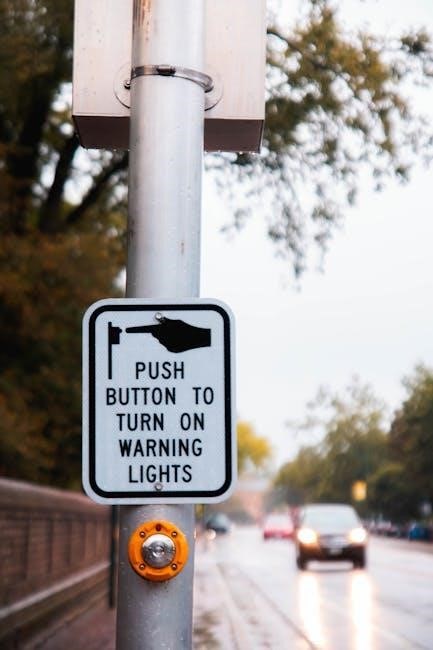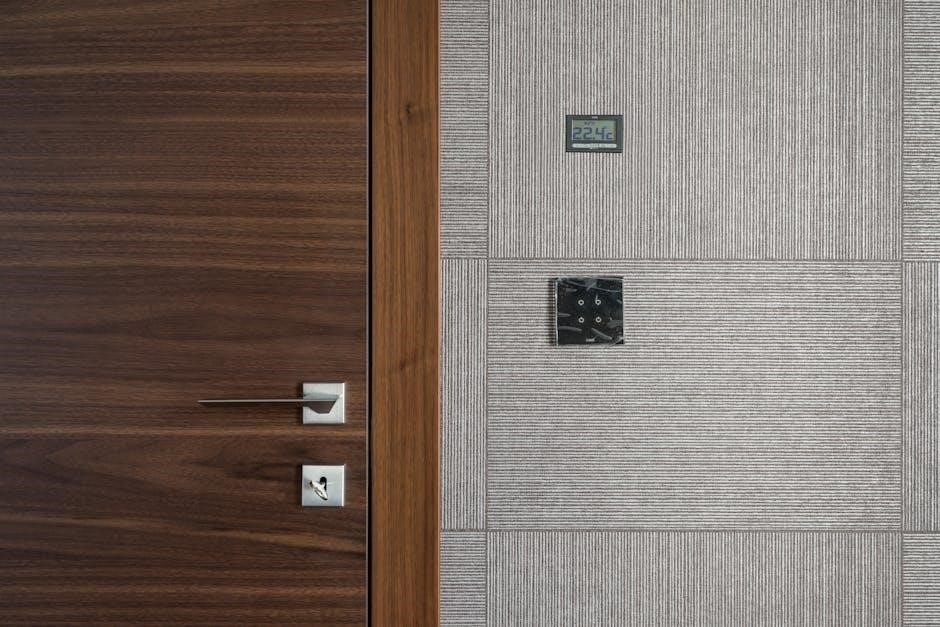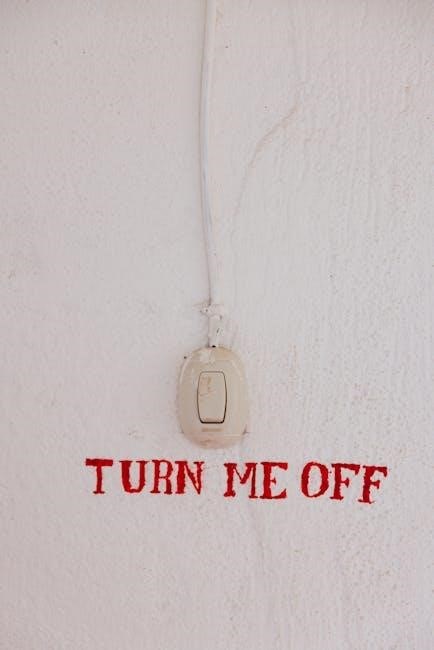Intermatic timer switches are versatile devices designed to control electrical appliances automatically. They offer convenient scheduling for lighting, HVAC, and other systems, enhancing energy efficiency and user convenience.

Installation Instructions
Ensure power is off before starting. Secure wires firmly, mount the timer, and cover with the wall plate. For three-way setups, install the remote switch.
Pre-Installation Steps
Before installing an Intermatic timer switch, ensure the power is turned off at the circuit breaker. Verify the timer model matches your electrical system’s voltage and requirements. Open the access door to check if the battery is installed and functioning. If a pull tab is present, remove it to activate the battery. Mount the timer at eye level for easy access, ensuring sufficient space for the cover to swing open. For three-way wiring, prepare the remote switch and its wall box. Refer to the installation manual for specific voltage settings and wiring diagrams to avoid errors during the process.
Physical Installation Process
Begin by securing the wires to the timer wall box, ensuring they are tightly connected. Use the provided screws to mount the timer firmly to the wall box. For three-way wiring, install the remote switch in its designated wall box. Cover both the timer and remote switch with their respective wall plates, securing them with screws. Ensure the voltage selector is set correctly for your system (e.g., 120, 208, or 240 VAC). Connect the remaining wires to the appropriate terminals, matching the wiring diagram in the manual; Finally, replace the battery holder and close the access door. Double-check all connections and settings before restoring power to test the timer’s functionality.

Programming the Timer
Press the MODE button to set the time and date. Use + or ⏤ to adjust hours, minutes, and year. Select the day of the week and enable DST if needed. Choose your time zone from the map in the manual.
Setting the Time and Date

To set the time and date on your Intermatic timer, press the MODE button until “SETUP” appears. Use the + or — buttons to adjust the hour and minutes. Press MODE again to advance to the year selection. Use the + or — buttons to set the correct year. Press MODE once more to select the day of the week. Ensure the correct day is chosen, as this affects scheduling. Press MODE again to enable or disable Daylight Saving Time (DST). If DST is enabled, select your time zone using the provided map in the installation manual. After completing these steps, press the ON/OFF button to save your settings and return to the main display.
Programming On/Off Events
Programming on/off events on an Intermatic timer allows you to schedule when your devices turn on or off automatically. Start by pressing the MODE button until “PGM” appears on the display. Use the + or — buttons to set the desired hour for the ON time, then press MODE to confirm. Repeat the process to set the minute for the ON time. Press MODE again to select the OFF time and repeat the process to set the hour and minute. Use the + or ⏤ buttons to choose the days for the event (e.g., ALL, M-F, WEEKENDS). Press ON/OFF to save the event. For additional events, repeat the process. Once all events are programmed, press MODE until “AUTO” appears to enable the timer. Ensure the timer is in RUN mode for the settings to take effect.

Features of Intermatic Timer Switches
Intermatic timer switches offer advanced features like Astro, self-adjusting capabilities, and options for mechanical or digital operation, catering to various scheduling needs efficiently.
Astro Feature
The Astro feature of Intermatic timer switches allows automatic scheduling based on sunrise and sunset times. This feature adjusts daily, syncing with local astronomical data for precise control of lighting or devices. Users can customize settings to turn devices on at dusk and off at dawn, eliminating manual adjustments. The timer calculates exact times annually, considering daylight saving changes. This functionality is ideal for outdoor lighting, ensuring energy efficiency and convenience. The Astro feature enhances automation, making it a standout option for modern smart homes. By integrating this technology, users enjoy seamless operation without constant programming updates. It’s a reliable solution for maintaining consistent schedules throughout the year.
Self-Adjusting Capability
Intermatic timer switches feature a self-adjusting capability, ensuring accurate operation without manual intervention. This technology automatically updates the timer based on the current time, date, and daylight saving settings. When the battery is replaced or after a power outage, the timer retains its programming and adjusts seamlessly. The self-adjusting feature eliminates the need for frequent recalibrations, providing reliable performance. It also adapts to seasonal changes, maintaining precise control over connected devices. This capability enhances user convenience, making it ideal for busy households or commercial settings. By automating adjustments, Intermatic timers ensure consistent operation, reducing the likelihood of human error and saving time. This feature is a key advantage for users seeking a low-maintenance, efficient timer solution.
Types of Timers: Mechanical vs. Digital
Intermatic timer switches are available in two primary types: mechanical and digital. Mechanical timers operate using a clock-driven mechanism, offering a simple and cost-effective solution for basic time management. Users manually set the desired on/off times by adjusting a dial or lever, making them ideal for straightforward applications. Digital timers, on the other hand, provide advanced features like programmable events, Astro functionality, and self-adjusting capabilities. They allow users to set custom schedules and automatically adapt to seasonal changes, offering greater flexibility and convenience. Both types cater to different needs, ensuring reliable control over electrical devices. Mechanical timers are best for simplicity, while digital timers suit those requiring sophisticated scheduling options. This variety ensures users can choose the timer that best fits their specific requirements.

Troubleshooting Common Issues
Identify malfunctions like timers not turning on/off or incorrect time settings. Resetting the timer or replacing the battery often resolves these issues. Check wire connections and consult the user manual for complex problems.

Diagnosing Timer Malfunctions
Identify issues by observing symptoms like the timer not turning on/off or displaying incorrect times. Check for loose wire connections or a faulty battery. Ensure the timer is properly mounted and powered. If the display is unresponsive, press and hold the ON/OFF button to reset. For models with astro features, verify the correct time zone and daylight saving settings. If the timer fails to trigger events, review programmed schedules and ensure they are saved.Consult the user manual for specific diagnostic steps, such as resetting or reprogramming. For complex issues, advanced troubleshooting may require accessing internal settings or replacing defective components. Always refer to the installation guide for model-specific instructions.
Resetting the Timer
To reset the Intermatic timer, press and hold the ON/OFF button. Use a paper clip or pen to press the RESET button located below it. Continue holding ON/OFF until “INIT” appears. Release and wait for the timer to display 12:00 AM. This process restores factory settings, clearing all programmed events. Note that the timer retains the year, month, and day if the battery is replaced within 15 seconds. After resetting, reprogram the time, date, and schedules. For models with astro features, reconfigure time zones and daylight saving settings. Ensure the battery is secure to avoid power loss during reset. Always refer to the user manual for specific reset instructions, as procedures may vary across models.

Maintenance and Care
Regular maintenance ensures optimal performance of Intermatic timer switches. Check the battery every 5-7 years and replace it with a compatible type to prevent data loss. Use a soft cloth to wipe the display and buttons, removing dust and debris. Avoid harsh chemicals that may damage the electronics. Inspect wires for secure connections and signs of wear. Replace any damaged wires promptly. For models with moving parts, ensure they operate smoothly without obstruction. Clean the timer’s exterior periodically to maintain functionality. Store manuals and user guides for reference. If the timer is exposed to moisture, ensure it is rated for such environments. Proper care extends the lifespan of your Intermatic timer, ensuring reliable operation and energy efficiency.

Intermatic timer switches are essential for modern electrical management, offering reliability and convenience. By following installation, programming, and maintenance guidelines, users can optimize energy use and appliance control. Troubleshooting tips help resolve common issues, ensuring uninterrupted operation. Intermatic timers adapt to various needs, from mechanical simplicity to advanced digital features like the Astro Function. Regular care and updates maintain performance, while their versatility suits residential and commercial settings. Whether automating lights or HVAC systems, Intermatic timers provide efficient, tailored solutions, enhancing comfort and energy savings; Proper setup and maintenance ensure longevity, making them a valuable investment for smart home management. With their robust features and ease of use, Intermatic timers remain a top choice for users seeking dependable automation.